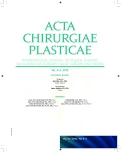A-02 SUBMENTAL AND SUPRACLAVICULAR FLAP
Authors:
Z. Dvořák 1,2,3; R. Pink 1,4; P. Michl 1,4; P. Heinz 1,4; P. Tvrdý 1,4
Authors‘ workplace:
Department of Oral and Maxillofacial Surgery University Hospital in Olomouc, Czech Republic
1; Department of Plastic and Aesthetic Surgery St. Anne University Hospital Brno, Czech Republic
2; Medical Faculty Masaryk University in Brno, Czech Republic
3; Medical Faculty Palacky University in Olomouc, Czech Republic
4
Published in:
ACTA CHIRURGIAE PLASTICAE, 57, 3-4, 2015, pp. 48-50
Category:
Selected abstracts from the 36th national congress of the czech society plastic surgery with international participation
Introduction
Reconstruction in the head and neck includes a range of reconstruction techniques, from local flaps to free flaps. One of the stages of the reconstructive ladder are regional or pedicled flaps. The choice of flap for reconstruction is based on the size and type of the tumor, expected curability considering general condition of the patient, concurrent diseases and overall life style of the patient. Submental and submandibular flap represent relatively new locoregional flaps used for reconstruction of head and neck defects. Submental flap was first reported by Martin in 19931, supraclavicular fasciocutaneous flap by Lamberty and Cormack in 1979, but „reinvented“ by the work of Pallua in 19972, who used it to solve post-burn mentosternal contractures. The goal of this presentation was to present a small group of patients in whom these flaps were used within reconstruction of postoncological head and neck defects and to analyze achieved results.
Method
Retrospective study of 6 patients (4 men and 2 women) operated within the period from 1. 6. 2014 to 30. 7. 2015 at the Department of Oral and Maxillofacial Surgery in Olomouc. All patients were primarily treated for squamous cell carcinoma in orofacial area. In 3 patients was used immediate reconstruction with a submental flap; in 3 patients delayed reconstruction of the head and neck defects with a supraclavicular flap. In 2 of them was used a supraclavicular flap for secondary reconstruction of defects localized on the neck and in 1 patient was supraclavicular flap used for secondary reconstruction of a facial defect in full thickness after controlled resection.
Results
Submental flap was used 3 times for reconstruction of a defect after resection of tongue squamous cell carcinoma and base of oral cavity (2 men, 1 woman). In all cases was observed complete survival of the flap and primary healing with minimal morbidity of donor site. Unfortunately, one patient experienced progression of squamous cell carcinoma from a metastatic lymph node localized in the submandibular area after 4 months. Supraclavicular flap was used 2 times in 2 male patients after radiotherapy for coverage of defects on the edge of the mandible and submandibular area, and 1 time in a female for reconstruction of the right cheek after full thickness resection. In one case occurred partial necrosis of the supraclavicular flap after infection caused by a combination of 4 highly virulent bacterial pathogens. Loss of a part of the flap was treated by a bilobed flap from pre- and retroauricular area. Other flaps survived completely and healed well.
Conclusion
The method of choice in the reconstruction of head and neck defects was usage of free flaps; local and regional flaps were a primary alternative for polymorbid patients unsuitable for microsurgical reconstruction, often after repeated radiotherapy or incapable of long general anesthesia. Submental and supraclavicular flaps represent thin, pliable, versatile and easy to dissect flaps with good cosmetic and functional results, possibility of one stage reconstruction and with minimal morbidity of donor site. With regards to the localization of the pedicle and body of the flap in the area of skin dissection IA, IB and IIA according to the classification of cervical lymph nodes of the American Academy for Surgery of the Head and Neck is the submental flap used usually only in T1 tumors of the oral cavity without the positivity of regional lymph nodes as shown by the imaging methods (ultrasound, contrast CT, PET CT). Supraclavicular flap is already now considered to be the golden standard for reconstruction of soft tissue defects in the head and neck3. (Fig. 2.1, 2.2, 2.3, 2.4.)




Labels
Plastic surgery Orthopaedics Burns medicine TraumatologyArticle was published in
Acta chirurgiae plasticae

2015 Issue 3-4
Most read in this issue
- 36th NATIONAL CONGRESS OF THE CZECH SOCIETY OF PLASTIC SURGERY WITH INTERNATIONAL PARTICIPATION
- Dorsoradial forearm flap with silicone bone spacer in reconstruction of A combined THUMB injury – case report
-
ZORA JANŽEKOVIČ
(September 30, 1918 – March 17, 2015) - Editorial
